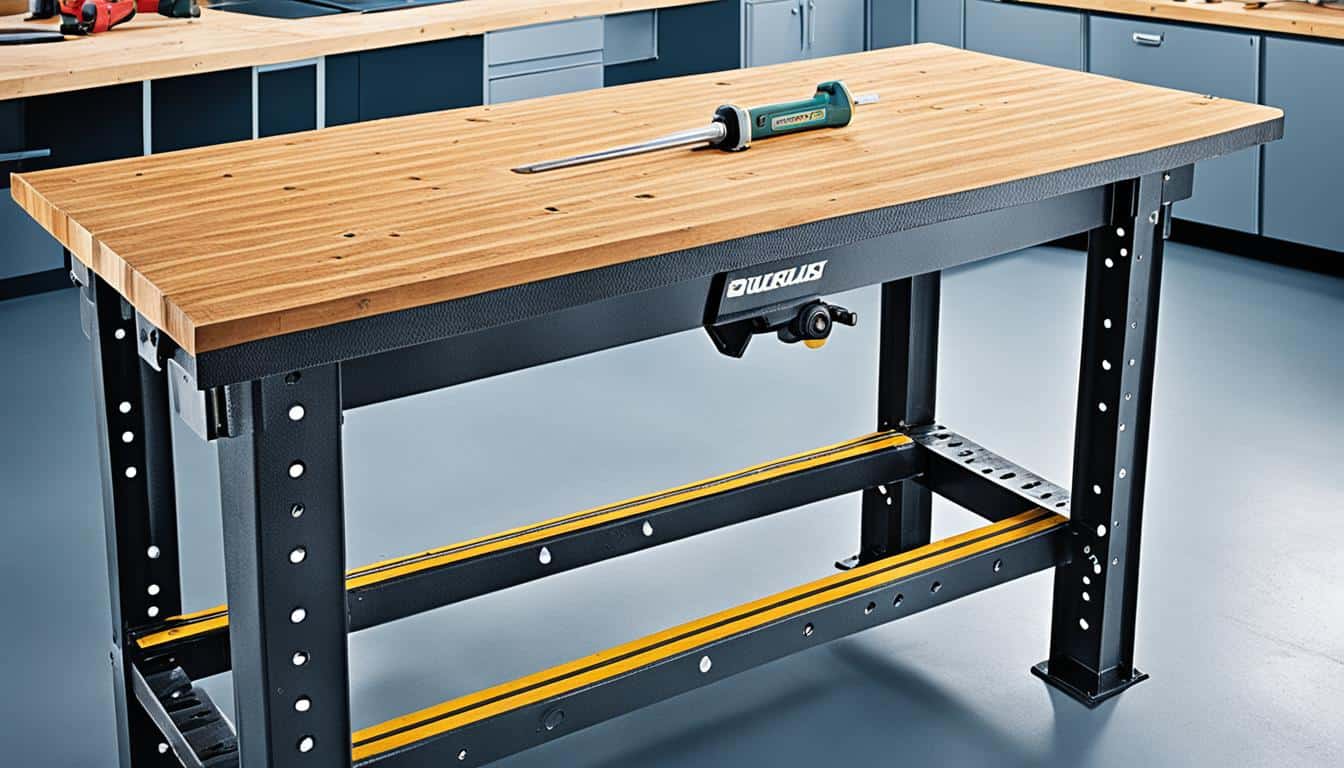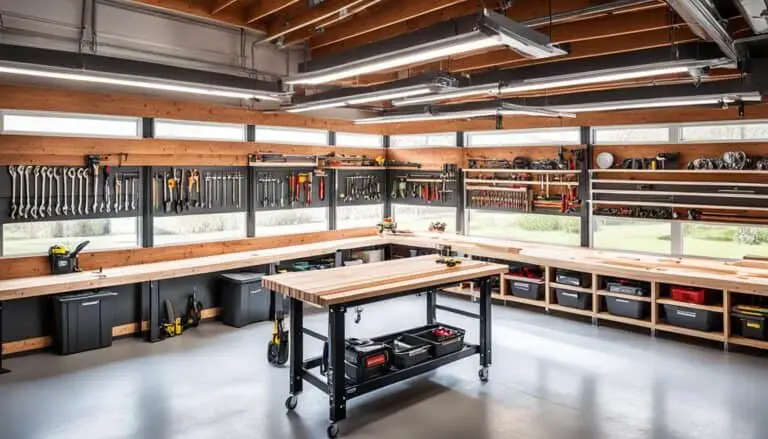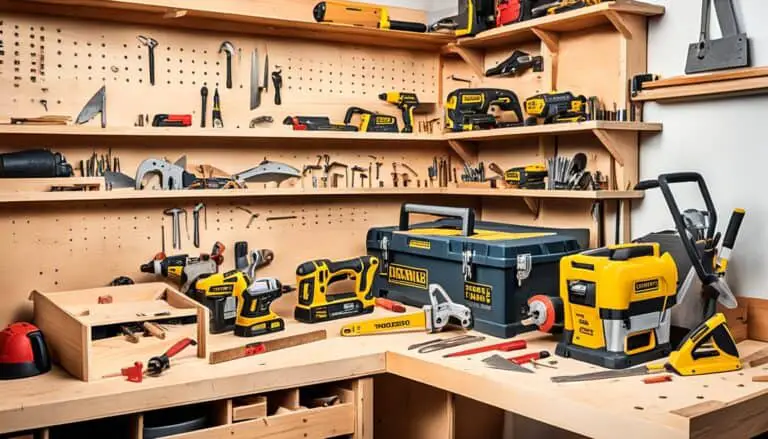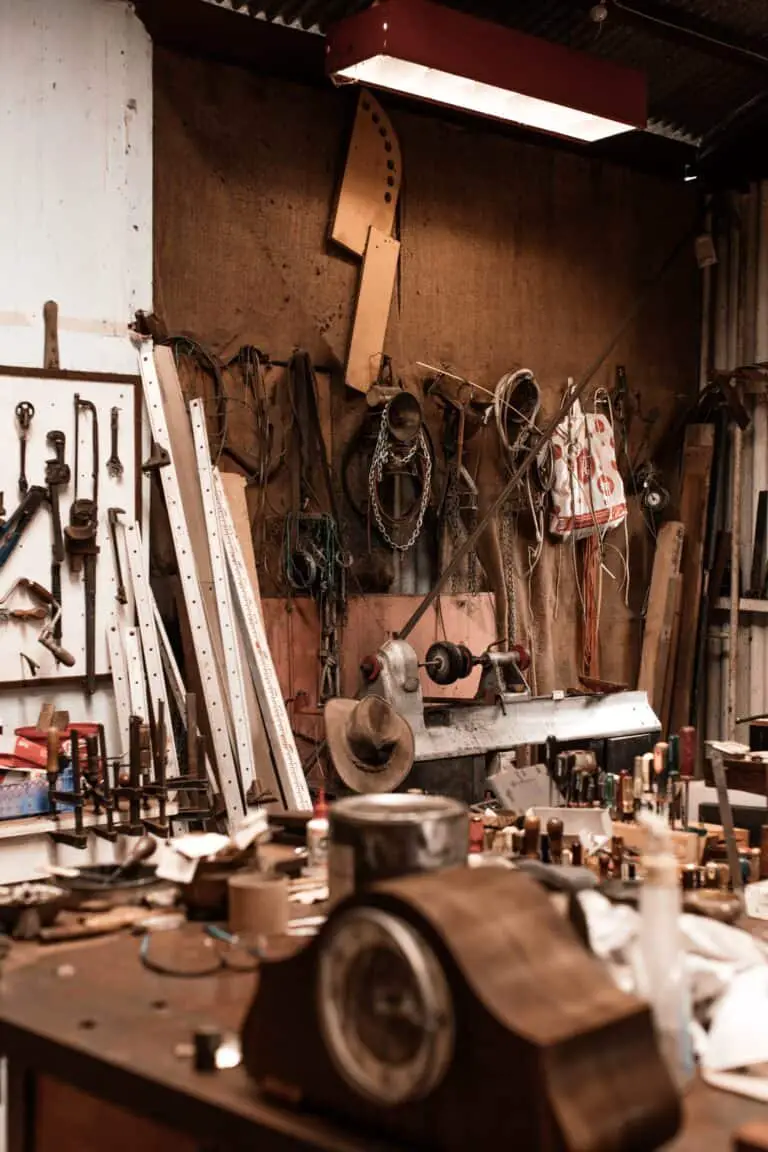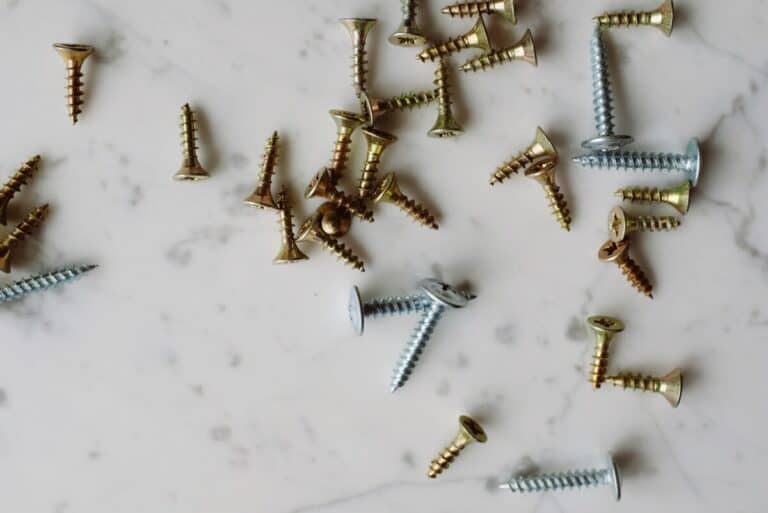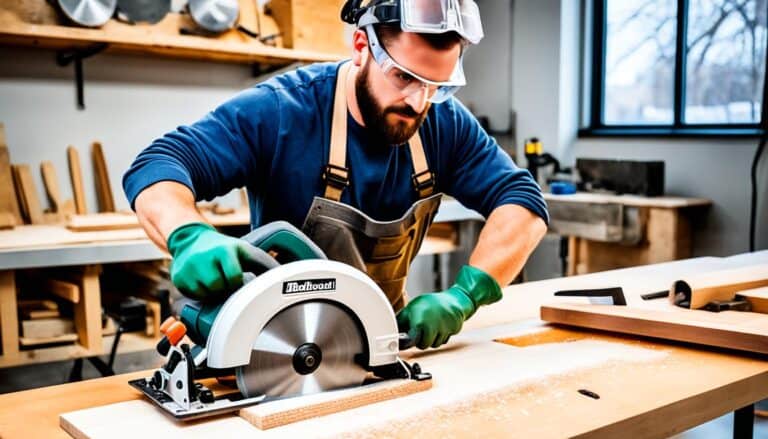When it comes to choosing a workbench top, durability is a key factor to consider. Whether you’re a professional woodworker, a DIY enthusiast, or someone who enjoys tinkering with tools, having a sturdy workbench top is essential for a productive and efficient workspace. Your workbench top should be able to withstand heavy-duty use, resist water and corrosion, and provide a reliable surface for all your projects.
There are several popular materials for workbench tops, each offering their own unique benefits. Ebony Star laminate, stainless steel, oak butcher block, MDF, and maple butcher block are all excellent choices that provide durability and longevity. By selecting the right workbench top material, you can ensure that your workbench is not only functional, but also built to last.
In this article, we will explore the different materials available for workbench tops and provide insights to help you choose the best option for your needs. We will also discuss important considerations such as maintenance, customization, and cost, so you can make an informed decision and create the perfect workbench for your projects.
Key Takeaways
- Choosing a durable workbench top is crucial for a productive and efficient workspace.
- Popular materials for workbench tops include Ebony Star laminate, stainless steel, oak butcher block, MDF, and maple butcher block.
- Consider factors such as the type of work you’ll be doing, equipment compatibility, and budget when selecting a workbench top material.
- Maintenance, customization options, and overall cost should also be taken into account.
- By choosing the right workbench top material, you can create a reliable and long-lasting surface for all your projects.
Popular Workbench Countertop Materials: An Overview
When it comes to creating a durable workbench surface, choosing the right countertop material is crucial. There are several popular options available that provide both strength and longevity. Understanding the characteristics of each material can help you make an informed decision for your workbench. Let’s explore these popular workbench countertop materials:

This image illustrates the characteristics and applications of different workbench materials, including wood, metal, and composite. Each part of the workbench is dedicated to a specific type of task, reflecting how the choice of material can influence the work environment and the projects you undertake.
Ebony Star Laminate
Ebony Star laminate is a textured, high-pressure laminate that offers exceptional toughness and durability. It is resistant to water, corrosion, stains, and impacts, making it ideal for heavy-duty workbenches. The textured surface provides a non-slip grip, ensuring stability during various tasks. In addition to its durability, Ebony Star laminate is easy to clean and maintain, making it a popular choice for many workbench enthusiasts.
Stainless Steel
Stainless steel is renowned for its strength and versatility. It can withstand both blunt and sharp force impacts, making it highly suitable for workbenches with mounted vices and tools. Stainless steel is resistant to rust, stains, and corrosion, ensuring a long-lasting workbench surface that can handle demanding tasks. Its smooth and hygienic finish also makes it easy to clean and maintain, making it a top choice for many professionals.
Oak Butcher Block
Oak butcher block is a sturdy and durable option for workbench tops. The natural beauty and warmth of oak add an attractive touch to any workspace. Oak butcher block can withstand heavy use and provides excellent resistance to impacts and scratches. With proper maintenance, such as regular oiling and sanding, an oak butcher block workbench can last for decades, making it a popular choice for woodworking enthusiasts.
Maple Butcher Block
Maple butcher block is another popular choice for its durability and strength. It is known for its resistance to impacts, knife cuts, and general wear and tear. Maple has a tight, dense grain that gives it excellent stability, making it suitable for heavy-duty workbenches. Similar to oak butcher block, maple requires regular maintenance, including oiling and sanding, to keep its beauty and longevity intact.
MDF (Medium-Density Fiberboard)
MDF is a cost-effective option that offers both strength and durability. It is composed of wood fibers and resin, resulting in a solid and stable material. MDF is resistant to warping and swelling, making it ideal for workbenches that may be exposed to moisture. Its smooth surface allows for easy cleaning and maintenance. While MDF may not possess the same natural beauty as solid wood, it remains a popular choice for those seeking an affordable and reliable workbench countertop.
With an overview of these popular workbench countertop materials, you can now make an informed decision based on your specific needs, preferences, and budget. Whether you prioritize durability, aesthetics, or affordability, there is a material that will suit your requirements and ensure a sturdy workbench surface for all your projects.
When selecting the best wood for your workbench top, you have a variety of durable and affordable options to consider, depending on the nature of your work, environment, and budget. Hardwoods like hickory, pinewood, hard maple, and Douglas fir offer a range of benefits from durability to ease of work, making them excellent choices for workbench tops. Exotic options like teak provide additional qualities such as moisture resistance and natural beauty (Woodworking Trade).
For those looking for alternative materials, medium-density fiberboard (MDF) and plywood are practical choices. MDF is appreciated for its smooth finish and resistance to moisture, making it a cost-effective option for various applications. Plywood, known for its strength and large sheet size, offers a durable and cost-effective solution for workbench tops (Woodworking Clarity).
Incorporating materials such as maple, oak, beech, or even exotic woods like teak and bubinga into your workbench can provide the durability, aesthetics, and functionality you need. Each wood type has its specific advantages, such as maple’s resilience and oak’s toughness, making them suitable for different types of workspaces (ToolsGearLab).
Additionally, workbench tops can be made from a variety of materials, not just wood. Butcher block, laminated hardwood, phenolic resin, steel, and even stainless steel are all viable options depending on your specific needs. Butcher block tops, for instance, are popular for their durability and ease of maintenance, while steel tops offer exceptional strength for heavy industrial applications (Global Industrial).
Ultimately, the choice of material for your workbench top should align with the specific requirements of your projects, taking into account factors such as the tools used, local climate, and desired finish (ToolsGearLab). Each material offers unique benefits, and selecting the right one can significantly impact the efficiency, comfort, and durability of your workspace.
Choosing the Best Workbench Countertop Material
Deciding on the best workbench countertop material depends on several factors. Consider the type of work you’ll be doing – if you’ll be using sharp blades and heavy power tools, maple wood or an oak butcher block is recommended. If you’ll be using a mixture of power and hand tools, adding a rubber topper to a butcher block can help absorb the force of any tool. The frequency of use and the need for portability should also be taken into account. Additionally, if the workbench countertop will be exposed to moisture, it is important to choose a material that is resistant to mold and rot.
Comparing Workbench Countertop Materials
| Material | Durability | Resistance to Moisture | Cost |
|---|---|---|---|
| Ebony Star laminate | High | Yes | Moderate |
| Stainless steel | Very high | Yes | High |
| Oak butcher block | High | No | Moderate |
| MDF | Moderate | No | Low |
| Maple butcher block | High | No | Moderate |
As seen in the table above, different workbench countertop materials have varying levels of durability, resistance to moisture, and cost. The choice of material will depend on your specific needs and preferences.
For example, if durability and resistance to moisture are top priorities, stainless steel or Ebony Star laminate would be suitable options. However, if you prefer the warmth and natural beauty of wood, oak butcher block or maple butcher block are excellent choices. MDF is a more budget-friendly option, but it may not offer the same level of durability as hardwood materials.
Ultimately, consider the type of work you’ll be doing, the environment in which your workbench will be located, and your budget when selecting the best workbench countertop material for your needs.
Other Considerations for Workbench Countertops
While choosing the right material for your workbench countertop is crucial, there are a few other factors you should consider to ensure its longevity and functionality.
Workbench Countertop Maintenance
To maintain the quality of your workbench countertop, it is important to follow proper maintenance practices. Regular cleaning with mild soap and water can help remove debris and keep the surface clean. For wood-based countertops, it is essential to promptly clean up any water spills to prevent mold and rot.
Additionally, consider adding rubber sheets on top of the workbench if you anticipate doing a lot of hammering. These sheets help disperse the blunt force impact, protecting the surface from damage.
Workbench Equipment Compatibility
Another crucial consideration is ensuring that the chosen material can withstand the weight and pressure of the equipment you’ll be using on your workbench. Different materials have varying strength capacities, so it is important to choose an option that matches your specific needs.
For example, if you’ll be using heavy power tools or mounting equipment like vises, a sturdy material like stainless steel or hardwood butcher block would be a suitable choice. On the other hand, if you’ll be using lighter hand tools, materials like MDF or plywood with a hardboard overlay can provide adequate support.
Plywood with Formica Laminate: A Viable Option?
If you’re considering different workbench top materials, plywood with Formica laminate could be a viable choice, especially if you’re looking for an easy-to-clean surface. The combination of plywood and Formica laminate provides a smooth and durable work surface that is resistant to stains and scratches.
Formica laminate is known for its low-maintenance nature, making it a popular choice for workbench tops. Its smooth surface is easy to wipe clean, ensuring that your workbench stays tidy and functional. Additionally, Formica laminate comes in a variety of colors and styles, allowing you to customize the look of your workbench to match your workspace aesthetic.
However, it’s important to consider the specific use of your workbench before choosing plywood with Formica laminate as the top material. While the laminate provides a smooth surface, it may not be suitable for heavy pounding or intensive tool use, as it can be brittle and slippery. If you anticipate using your workbench for tasks that require significant force or impact, you may want to explore alternative materials that offer greater durability and impact resistance.
Ultimately, the decision to use plywood with Formica laminate as a workbench top material depends on your specific needs and preferences. Evaluate the types of projects you’ll be working on, the level of durability required, and the potential for heavy tool use. By carefully assessing your needs, you can choose a workbench top material that will provide the functionality and longevity you desire.
Alternatives to Plywood with Formica Laminate
If plywood with formica laminate does not meet your requirements, there are several alternatives to consider. Here are some durable and versatile workbench top materials:
- Particle board with a hardboard top: This combination provides a sturdy and affordable work surface. The particle board offers strength and stability, while the hardboard top adds durability and a smooth working area.
- Construction lumber: Utilizing construction lumber, such as 2x4s, can create a solid workbench top. This option may require additional finishing to smooth any rough edges but offers a reliable and robust surface.
- Solid wood: Choosing solid wood, such as maple or beech, can provide a natural and durable workbench top. These hardwoods are known for their strength and resistance to wear and tear.
- Repurposed materials: Consider repurposing industrial doors or countertop offcuts for your workbench top. This eco-friendly option can offer a unique and cost-effective solution.
Ultimately, the choice of material will depend on your specific needs and preferences. Factors such as budget, desired aesthetics, and the type of work you’ll be doing should guide your decision-making process.
Alternatives to Plywood with Formica Laminate Comparison
| Workbench Top Material | Durability | Affordability | Appearance |
|---|---|---|---|
| Particle board with hardboard top | Durable | Affordable | Smooth and uniform |
| Construction lumber | Sturdy | Affordable | Natural grain and texture |
| Solid wood (maple or beech) | Highly durable | Varies based on wood species | Warm and natural |
| Repurposed materials | Depends on chosen material | Varies based on availability | Unique and eclectic |
Replacing and Resurfacing Workbench Tops
Over time, your workbench top may experience wear and tear, requiring replacement or resurfacing to maintain its functionality and aesthetics. The process of replacing or resurfacing your workbench top depends on its current condition and your specific needs.
Adding a Fresh Surface
If your workbench top is still structurally sound but has cosmetic damage or signs of wear, you can consider adding a new layer of material to refresh its surface. One option is to add a layer of Medium-Density Fiberboard (MDF) or hardboard on top of the existing surface. These materials are affordable, readily available, and can provide a smooth and durable work surface.
Tip: Before adding the new layer, ensure that the workbench top is clean and free of any debris or old adhesive. Sanding the existing surface lightly can also help provide better adhesion for the new layer.
Complete Replacement with Quality Materials
In cases where the entire workbench top needs replacement due to extensive damage or when you desire an upgrade, there are various high-quality materials to consider. These materials offer durability and strength, ensuring that your workbench top can withstand heavy-duty use.
Some recommended materials for complete replacement include:
- Laminated Beech
- Maple Butcher Block
- Repurposed Materials like Industrial Doors
Laminated beech provides a tough and resilient surface, resistant to scratches and moisture. Maple butcher block offers natural beauty and exceptional strength, making it ideal for heavy-duty work. Repurposed industrial doors can provide a unique and durable workbench top option while being environmentally friendly.
When replacing the entire workbench top, ensure that it is accurately measured and cut to fit your workbench’s dimensions properly. Seek professional assistance if necessary to ensure accuracy and precision.
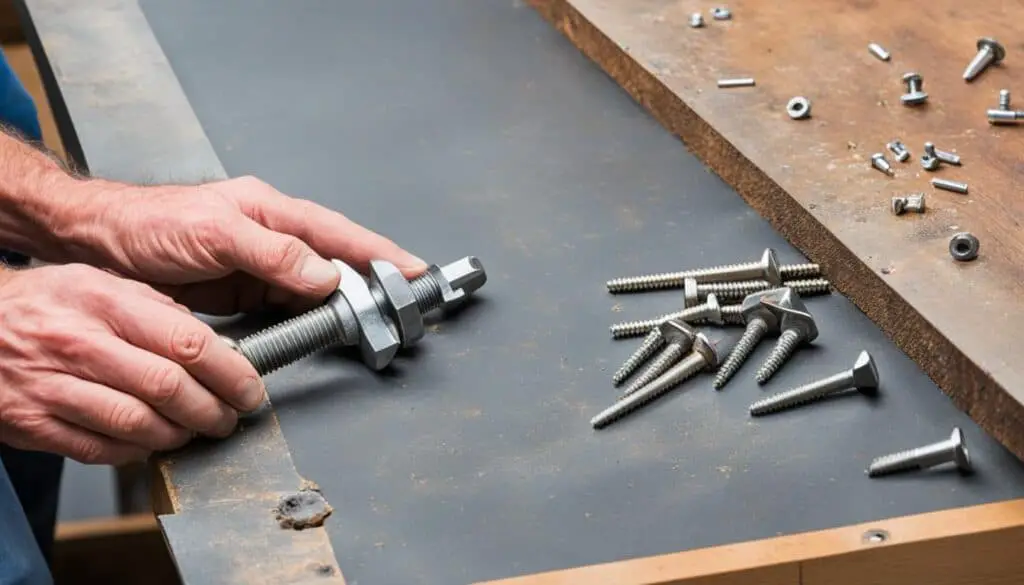
Maintenance for Workbench Top Longevity
Regular maintenance is essential to extend the lifespan of your workbench top, regardless of whether you choose to resurface or replace it. Here are some maintenance tips to keep your workbench top in optimal condition:
- Regularly clean the surface using a mild soap and water solution to remove dust, debris, and spills.
- Periodically sand the surface to smooth out any rough spots or imperfections.
- Apply finishes, such as wood sealers or protective coatings, to enhance durability and protect against moisture.
- Promptly clean up any spills to prevent staining or damage to the workbench top.
Note: Depending on the material of your workbench top, specific maintenance requirements may apply. Always refer to the manufacturer’s guidelines for optimal care and maintenance.
By following these maintenance practices, you can ensure that your workbench top remains in excellent condition, providing a sturdy and reliable surface for your projects.
Workbench Top Materials for Specific Uses
Choosing the right workbench top material is crucial for the specific tasks you’ll be performing. Different materials offer unique advantages to meet your needs. Consider the following specialized workbench tops based on specific uses:
Non-Slip Surfaces for Glue-Up or Assembly
If you require a non-slip surface to ensure stability during glue-up or assembly tasks, consider a plywood top with a non-slip coating or a hardboard overlay. These options provide added grip, preventing your projects from slipping or shifting during delicate maneuvers.
Heavy-Duty Work with Sharp Blades or Power Tools
For heavy-duty work involving sharp blades or power tools, solid wood tops like oak butcher block or maple butcher block are ideal choices. These materials offer excellent durability, strength, and stability, allowing you to confidently tackle demanding projects without compromising safety or precision.
Remember to also consider the overall weight capacity of your workbench when selecting a material for heavy-duty applications.
Here is a comparison table highlighting the key features of specialized workbench top materials:
| Workbench Top Material | Advantages | Uses |
|---|---|---|
| Oak Butcher Block | Durable and can withstand heavy-duty use | Heavy-duty work with sharp blades or power tools |
| Maple Butcher Block | Strong and resilient | Heavy-duty work with sharp blades or power tools |
| Plywood with Non-Slip Coating | Provides a non-slip surface for added stability | Glue-up or assembly tasks |
Choose a workbench top material that suits your specific needs and ensures optimal performance and safety for your projects. The right material can significantly enhance your workflow and productivity.
DIY Options for Workbench Tops
If you have the skills and tools, building your own workbench top can be a rewarding project. Not only does DIY allow for customization, but it can also be a cost-effective alternative. There are several DIY options to consider when it comes to creating your homemade workbench countertop.
Joining Construction Lumber
One option is to use construction lumber, such as 2x4s, to create a sturdy workbench top. By joining these pieces together, you can form a solid surface capable of withstanding heavy-duty use. This method is relatively simple and affordable, making it a popular choice for DIY enthusiasts.
Plywood with Hardboard Overlay
Another DIY option is to use plywood as the base material and add a hardboard overlay. This combination provides both durability and a smooth work surface. Plywood is readily available and easy to work with, while the hardboard overlay adds an extra layer of strength and protection for your workbench top.
Repurposed Materials
If you’re feeling creative, you can repurpose materials like industrial doors or countertop offcuts to create a unique and custom-sized workbench top. This allows you to tailor the dimensions to fit your specific workspace, making it a highly personalized option. Not only does repurposing materials offer an eco-friendly solution, but it can also add character to your DIY workbench top.
Regardless of the DIY method you choose, make sure to carefully plan and measure before starting your project. This will help ensure that your homemade workbench countertop fits your needs and provides a stable and functional surface.
| DIY Workbench Top Option | Pros | Cons |
|---|---|---|
| Joining Construction Lumber | Provides a sturdy and affordable option | May require additional finishing for a smooth surface |
| Plywood with Hardboard Overlay | Durable and offers a smooth work surface | Requires additional materials for overlay |
| Repurposed Materials | Allows for customization and unique design | May require more effort to source materials |
Assessing Workbench Top Thickness and Weight
When selecting a workbench top, it’s essential to consider the thickness and weight of the material. These factors can significantly impact the stability and portability of your workbench.
Thicker Tops:
Thicker workbench tops, such as those made from laminated beech or maple butcher block, offer increased durability and strength. These materials can handle heavy-duty tasks and provide a stable surface for your projects. However, keep in mind that thicker tops are generally heavier and less portable than thinner options.
Thinner Tops:
On the other hand, thinner workbench tops, like those made from plywood or MDF, are lighter and easier to move around. They can be a great choice if portability is a priority in your workspace. However, thinner tops may sacrifice some durability compared to their thicker counterparts.
To determine the ideal thickness and weight for your workbench top, assess the specific needs of your workspace and the nature of your projects. Consider the following questions:
- Will you be working with heavy equipment or tools that require a sturdy surface?
- Do you need the flexibility to move your workbench to different locations?
- How often will you be using the workbench and for what types of tasks?
By answering these questions and evaluating your requirements, you can determine the optimal thickness and weight for your workbench top, ensuring it provides the stability and portability you need.
Comparison of Workbench Top Thickness and Weight
| Material | Thickness | Weight |
|---|---|---|
| Laminated Beech | 1.5-2 inches | Heavy |
| Maple Butcher Block | 1.5-2 inches | Heavy |
| Plywood | 0.5-0.75 inches | Light |
| MDF | 0.75 inches | Light |
Adding Accessories to Workbench Tops
Enhance the functionality and customization of your workbench top by adding accessories tailored to your specific needs. These accessories can optimize your workflow and make your workbench more versatile, allowing you to tackle a wide range of projects with ease.
Built-in vices
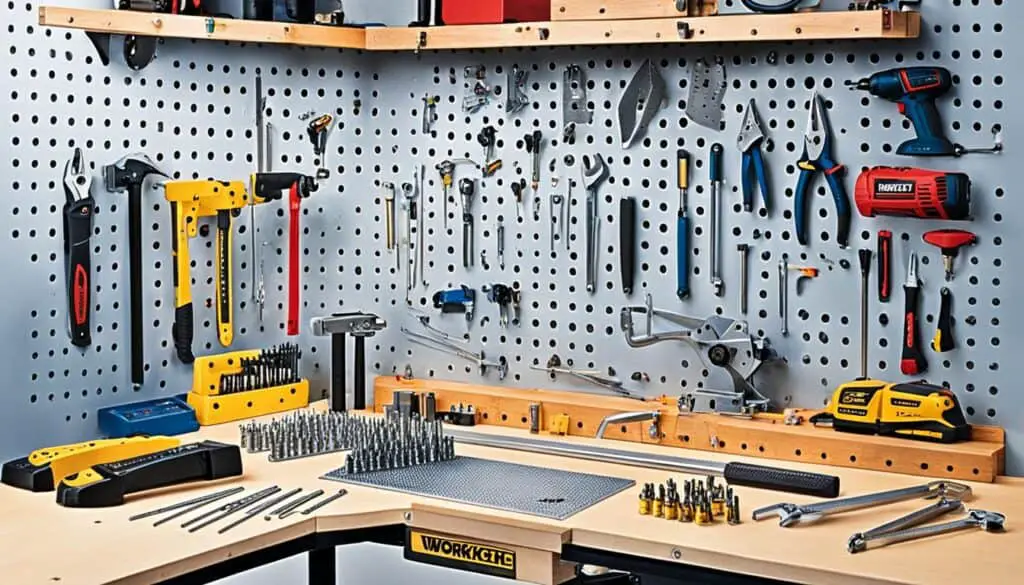
Add built-in vices to your workbench top for secure clamping and holding of your workpieces. Vices provide a stable and reliable grip, allowing you to firmly secure materials in place while you work on them. This is particularly useful for tasks that require precision and stability, such as woodworking or metalworking.
T-track systems
“The inclusion of T-track systems on your workbench top provides a versatile solution for clamping and using hold downs.”
T-track systems consist of grooves embedded in the workbench top that allow for the quick and easy attachment of clamps, hold downs, and other accessories. This provides flexibility in positioning tools and materials, enabling you to secure them in place securely. Whether you’re working with large or small projects, T-track systems offer added convenience and organization.
Custom holes for bench dogs
| Accessory | Description |
|---|---|
| Bench dogs | Small pins that can be inserted into custom holes on the workbench top for securing and positioning workpieces. |
Create custom holes in your workbench top to accommodate bench dogs. Bench dogs are small pins that fit into these holes, providing a versatile solution for securing and positioning workpieces. By strategically placing bench dogs, you can firmly hold your workpieces in place, allowing for precise and controlled cutting, sanding, or assembly.
The addition of these accessories to your workbench top can significantly enhance its functionality and adaptability, enabling you to work more efficiently and effectively on a variety of projects. Choose the accessories that align with your specific tasks and work style to optimize your workbench for success.
The Importance of Workbench Countertop Maintenance
Proper maintenance is essential for keeping your workbench countertop in optimal condition. By following a few simple maintenance practices, you can ensure that your workbench top remains durable and functional for years to come.
Regular Cleaning:
Regularly clean your workbench countertop using mild soap and water. This will help remove debris, stains, and spills, keeping the surface clean and hygienic. Avoid using harsh chemical cleaners, as they can damage the material.
Wood-Based Countertops:
If your workbench top is made of wood, it is important to periodically sand the surface to smooth out any rough spots and prevent splintering. Applying finishes, such as varnish or oil, will provide an added layer of protection against moisture and wear.
Prompt Clean-Up:
Accidents happen, but prompt clean-up of spills is crucial to prevent any potential damage to your workbench top. Liquids, especially those containing corrosive substances, can penetrate the surface and compromise its integrity. Always wipe up spills immediately to avoid any lasting effects.
Regular Inspection:
Regularly inspect your workbench top for any signs of damage, wear, or potential issues. Look for cracks, chips, or warping that may require repair or attention. Catching problems early can prevent further damage and help prolong the lifespan of your workbench top.
Maintaining your workbench top is an investment in its longevity and functionality. By adhering to these maintenance practices, you can ensure that your workbench countertop remains in optimal condition, providing you with a reliable surface for all your projects.
Longevity and Durability of Workbench Tops
The longevity and durability of a workbench top depend on several factors, including the chosen material, the level of maintenance, and the type of use. By selecting high-quality materials, such as laminated beech, stainless steel, or hardwood butcher block, you can ensure that your workbench top can withstand heavy-duty use and last for decades with proper care.
Maintaining your workbench top is crucial for its longevity. Regular maintenance, such as sanding and finishing, can prevent damage and extend its lifespan. Additionally, prompt clean-up of spills can protect the surface from stains and reduce the risk of moisture damage.
Here is a table that provides a comparison of the durability and maintenance requirements of popular workbench top materials:
| Workbench Top Material | Durability | Maintenance |
|---|---|---|
| Laminated Beech | Durable and resistant to wear | Regular sanding and reapplication of finish |
| Stainless Steel | Highly durable and resistant to corrosion | Regular cleaning to remove smudges and stains |
| Hardwood Butcher Block | Sturdy and can withstand heavy use | Sanding and periodic application of food-safe oils |
It’s important to note that the longevity of your workbench top will also depend on the level of usage and the demands of your projects. A workbench top used for light woodworking projects will typically last longer than one used for heavy metalworking tasks.
Remember to choose a workbench top material that aligns with your specific needs and will provide the necessary durability and functionality for your projects.
Cost Considerations for Workbench Tops
When it comes to choosing a workbench top, cost is an important factor to consider. The price of a workbench top will depend on the selected material and the size of the workbench. Different materials have varying price ranges, so it’s crucial to evaluate the cost against the desired durability and functionality of your workbench top.
Materials like laminated beech or stainless steel tend to be more expensive due to their high-quality and long-lasting nature. These options offer excellent durability and resistance to wear and tear. On the other hand, if you have a limited budget, there are more affordable choices available.
Plywood or particle board with a hardboard overlay can be cost-effective alternatives. These materials provide a sturdy and reliable work surface at a lower price point. They are suitable for light to medium-duty tasks and offer good value for money.
If you’re the DIY type, you can even consider repurposing materials to create a budget-friendly workbench top. Industrial doors or countertop offcuts can be transformed into functional work surfaces with a bit of creativity and craftsmanship.
| Material | Price Range | Durability | Functionality |
|---|---|---|---|
| Laminated Beech | High | Excellent | High |
| Stainless Steel | High | Excellent | High |
| Plywood with Hardboard Overlay | Medium | Good | Medium |
| Particle Board with Hardboard Overlay | Low | Fair | Low |
| Repurposed Materials | Low | Varies | Varies |
Remember, while cost is an important consideration, it’s essential to find the right balance between affordability and the quality you need for your projects. Assess your budget and weigh the cost against the desired durability and functionality to make an informed decision on your workbench top.
Workbench Top Selection and Personal Preference
When it comes to choosing the perfect workbench top, personal preference plays a significant role. You need to consider various factors, including the type of work you’ll be doing, the equipment you’ll be using, your budget, and your specific needs and preferences. By carefully evaluating these factors, you can make an informed decision and select a workbench countertop that aligns with your requirements.
There are several options available in the market, each with its own pros and cons. Let’s take a closer look at some popular workbench top materials:
| Material | Pros | Cons |
|---|---|---|
| Laminated Beech | Durable and long-lasting | Relatively expensive |
| Stainless Steel | Resistant to water, corrosion, and impact | Can be noisy and cold |
| Oak Butcher Block | Tough and durable | Requires regular maintenance |
| MDF | Affordable and sturdy | Not as durable as solid wood |
| Maple Butcher Block | Durable and attractive | Can be expensive |
After reviewing the available options, it’s essential to weigh the pros and cons of each material against your specific needs. Consider the type of workbench top that will provide you with the necessary durability, functionality, and aesthetics for your projects. Remember to also factor in your budget and maintenance requirements.
By considering your personal preferences and conducting thorough research, you can confidently select a workbench top material that will not only meet your practical needs but also align with your individual style and taste.
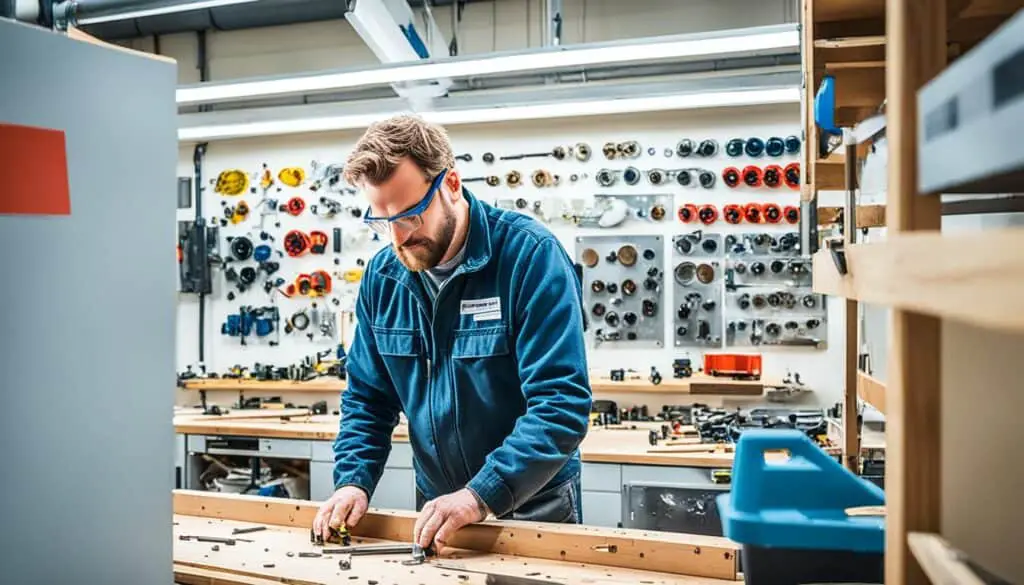
Having a workbench top that caters to your personal preferences will enhance your overall work experience and productivity. So take your time, explore the available options, and choose the perfect workbench top that will support you in completing your projects with ease and satisfaction.
Conclusion
Choosing the right workbench top is crucial for creating a durable and functional workspace. Materials such as laminated beech, stainless steel, oak butcher block, MDF, and maple butcher block each offer unique benefits that can meet the demands of different projects.
To select the best workbench top for your needs, consider factors such as durability, functionality, personal preference, and budget. Assess how each material performs in terms of durability, resistance to water and corrosion, and ability to withstand heavy-duty use. Also, consider the level of maintenance required to keep your workbench top in optimal condition.
By carefully evaluating these factors and making an informed decision, you can create a reliable and long-lasting surface for all your projects. Whether you choose the sleek and tough stainless steel, the classic beauty of oak butcher block, or the affordability of MDF, your workbench top should provide the strength and durability necessary for your specific work.
Investing in a high-quality workbench top not only ensures its longevity but also enhances your overall productivity and satisfaction in completing your projects. So take the time to evaluate your options, choose the material that best suits your needs, and enjoy the benefits of a sturdy workbench top for years to come.
FAQ
How do I choose the best workbench countertop material?
Consider factors such as the type of work you’ll be doing, the equipment you’ll be using, your budget, and your specific needs and preferences.
What are some popular workbench countertop materials?
Popular options include Ebony Star laminate, stainless steel, oak butcher block, MDF, and maple butcher block.
How do I maintain a workbench countertop?
Regular cleaning with mild soap and water, sanding, applying finishes, and prompt clean-up of spills can help maintain the workbench countertop in optimal condition.
What are some alternatives to plywood with formica laminate for a workbench top?
Alternatives include particle board with a hardboard top, solid wood like maple or beech, and repurposed materials like industrial doors or countertop offcuts.
How do I replace or resurface a workbench top?
If the current top is still structurally sound, you can add a layer of MDF or hardboard for a fresh surface. Otherwise, consider materials like laminated beech, maple butcher block, or repurposed materials for a full replacement.
What is the importance of workbench top thickness and weight?
Thicker tops offer greater durability and strength, but may be heavier and less portable. Thinner tops can be lighter and easier to move, but may sacrifice some durability.
Can I customize my workbench top?
Yes, you can enhance the functionality and versatility of your workbench top by adding accessories such as built-in vices, T-track systems, or custom holes for bench dogs.
How do I ensure the longevity and durability of my workbench top?
Choose high-quality materials, perform regular maintenance, and consider the level of usage and demands of your projects.
What are the cost considerations for a workbench top?
The cost will vary depending on the chosen material and the size of the workbench. Consider your budget and weigh the cost against the desired durability and functionality.
What factors should I consider when selecting a workbench top?
Consider the type of work, equipment compatibility, specific project requirements, and personal preferences to make an informed decision.


